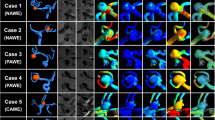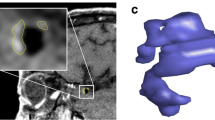Abstract
Objective
Aneurysm wall enhancement (AWE) on MRI has been considered an imaging marker to indicate active aneurysm inflammation, but no prospective studies have assessed the ability of AWE to predict rupture risk or growth. We aim to study the association of AWE with traditional risk factors and the estimated rupture risk.
Methods
Seventy-seven patients (mean age, 58.4 ± 10.8 years; 57% female) with 88 asymptomatic intracranial saccular aneurysms underwent both 3-T high-resolution MRI and three-dimensional (3D) rotational digital subtraction angiography (DSA). Geometric and morphologic parameters were measured on DSA, and the degree of AWE on MRI was graded. One- and 5-year rupture risks of aneurysms were estimated using the UCAS and PHASES calculator. Parameters associated with AWE were analyzed using uni- and multivariate logistic regression.
Results
Non-internal carotid artery location (OR 3.4, 95% CI 1.6-7.1) and aneurysm size (OR 1.9, 95% CI 1.3-2.7) were independently associated with AWE (p < 0.05). Aneurysms with AWE had significantly higher estimated rupture risk (1 and 5 year, 1.9% and 5.8%) than aneurysms without AWE (0.5% and 2.1%) (p < 0.001). Stronger and larger areas of AWE were correlated with the aneurysm size, size ratio and estimated rupture risk (R2 ≥ 0.30) (p < 0.01).
Conclusions
Prospective assessment of asymptomatic intracranial aneurysms with MRI suggests that AWE is associated with traditional risk factors and estimated short- and medium-term rupture risk.
Key Points
• AWE independently associates with aneurysm location and size.
• Aneurysms with AWE have higher rupture risk than aneurysms without AWE.
• Stronger and larger areas of AWE correlated with the aneurysm size, size ratio and rupture risk.




Similar content being viewed by others
Abbreviations
- 3D:
-
Three-dimensional
- AR:
-
Aspect ratio
- AWE:
-
Aneurysm wall enhancement
- CI:
-
Confidence interval
- CV:
-
Coefficient of variance
- DSA:
-
Digital subtraction angiography
- IA:
-
Intracranial aneurysm
- ICA:
-
Internal carotid artery
- ICC:
-
Intra-class correlation coefficient
- MCA:
-
Middle cerebral artery
- OR:
-
Odds ratio
- SPACE:
-
Fast spin echo with variable flip angle trains
- SR:
-
Size ratio
- TOF:
-
Time of flight
- UIA:
-
Unruptured intracranial aneurysm
References
Wiebers DO, Whisnant JP, Huston J III et al (2003) Unruptured intracranial aneurysms: natural history, clinical outcome, and risks of surgical and endovascular treatment. Lancet 362:103–110
Harada K, Fukuyama K, Shirouzu T et al (2013) Prevalence of unruptured intracranial aneurysms in healthy asymptomatic Japanese adults: differences in gender and age. Acta Neurochir (Wien) 155:2037–2043
Amber I, Mohan S, Nucifora P (2015) Intracranial aneurysms: a game of millimeters. Acad Radiol 22:1020–1023
Etminan N, Rinkel GJ (2015) Cerebral aneurysms: cerebral aneurysm guidelines-more guidance needed. Nat Rev Neurol 11:490–491
Korja M, Kaprio J (2016) Controversies in epidemiology of intracranial aneurysms and SAH. Nat Rev Neurol 12:50–55
Thompson BG, Brown RD Jr, Amin-Hanjani S et al (2015) Guidelines for the Management of Patients With Unruptured Intracranial Aneurysms A Guideline for Healthcare Professionals From the American Heart Association/American Stroke Association. Stroke 46:2368–2400
Serrone JC, Tackla RD, Gozal YM et al (2016) Aneurysm growth and de novo aneurysms during aneurysm surveillance. J Neurosurg 125:1374–1382
Teo M, St George EJ (2016) Radiologic surveillance of untreated unruptured intracranial aneurysms: a single surgeon's experience. World Neurosurg 90:20–28
Edjlali M, Gentric JC, Regent-Rodriguez C et al (2014) Does aneurysmal wall enhancement on vessel wall MRI help to distinguish stable from unstable intracranial aneurysms? Stroke 45:3704–3706
Omodaka S, Endo H, Niizuma K et al (2016) Quantitative assessment of circumferential enhancement along the wall of cerebral aneurysms using MR imaging. AJNR Am J Neuroradiol 37:1262–1266
Greving JP, Wermer MJ, Brown RD Jr et al (2014) Development of the PHASES score for prediction of risk of rupture of intracranial aneurysms: a pooled analysis of six prospective cohort studies. Lancet Neurol 13:59–66
Morita A, Kirino T, Hashi K et al (2012) The natural course of unruptured cerebral aneurysms in a Japanese cohort. N Engl J Med 366:2474–2482
Zhu C, Haraldsson H, Tian B et al (2016) High resolution imaging of the intracranial vessel wall at 3 and 7 T using 3D fast spin echo MRI. MAGMA 29:559–570
Juvela S, Poussa K, Porras M (2001) Factors affecting formation and growth of intracranial aneurysms: a long-term follow-up study. Stroke 32:485–491
Song J, Kim BS, Shin YS (2015) Treatment outcomes of unruptured intracranial aneurysm; experience of 1,231 consecutive aneurysms. Acta Neurochir (Wien) 157:1303–1310 discussion 1311
Fu Q, Guan S, Liu C et al (2017) Clinical significance of circumferential aneurysmal wall enhancement in symptomatic patients with unruptured intracranial aneurysms: a high-resolution MRI study. Clin Neuroradiol. https://doi.org/10.1007/s00062-017-0598-4
Nagahata S, Nagahata M, Obara M et al (2014) Wall enhancement of the intracranial aneurysms revealed by magnetic resonance vessel wall imaging using three-dimensional turbo spin-echo sequence with motion-sensitized driven-equilibrium: a sign of ruptured aneurysm? Clin Neuroradiol 26:277–283
Chalouhi N, Hoh BL, Hasan D (2013) Review of cerebral aneurysm formation, growth, and rupture. Stroke 44:3613–3622
Hu P, Yang Q, Wang DD et al (2016) Wall enhancement on high-resolution magnetic resonance imaging may predict an unsteady state of an intracranial saccular aneurysm. Neuroradiology 58:1–7
Portanova A, Hakakian N, Mikulis DJ et al (2013) Intracranial vasa vasorum: insights and implications for imaging. Radiology 267:667–679
Wang GX, Wen L, Lei S et al (2017) Wall enhancement ratio and partial wall enhancement on MRI associated with the rupture of intracranial aneurysms. J Neurointerv Surg. https://doi.org/10.1136/neurintsurg-2017-013308
Kazi M, Thyberg J, Religa P et al (2003) Influence of intraluminal thrombus on structural and cellular composition of abdominal aortic aneurysm wall. J Vasc Surg 38:1283–1292
Vorp DA, Lee PC, Wang DH et al (2001) Association of intraluminal thrombus in abdominal aortic aneurysm with local hypoxia and wall weakening. J Vasc Surg 34:291–299
Wang JY, Smith R, Ye X et al (2015) Serial imaging surveillance for patients with a history of intracranial aneurysm: risk of de novo aneurysm formation. Neurosurgery 77:32–42 discussion 42-33
Fanning NF, Willinsky RA, ter Brugge KG (2008) Wall enhancement, edema, and hydrocephalus after endovascular coil occlusion of intradural cerebral aneurysms. J Neurosurg 108:1074–1086
Zhu C, Graves MJ, Yuan J et al (2014) Optimization of improved motion-sensitized driven-equilibrium (iMSDE) blood suppression for carotid artery wall imaging. J Cardiovasc Magn Reson 16:61
Zhu C, Haraldsson H, Faraji F et al (2016) Isotropic 3D black blood MRI of abdominal aortic aneurysm wall and intraluminal thrombus. Magn Reson Imaging 34:18–25
Funding
This study has received funding by National Natural Science Foundation of China (nos. 81670396, 31470910) and NIH grant K99HL136883.
Author information
Authors and Affiliations
Corresponding author
Ethics declarations
Guarantor
The scientific guarantor of this publication is Prof. Jianping Lu.
Conflict of interest
The authors of this manuscript declare no relationships with any companies, whose products or services may be related to the subject matter of the article.
Statistics and biometry
One of the authors has significant statistical expertise.
Informed consent
Written informed consent was obtained from all subjects (patients) in this study.
Ethical approval
Institutional Review Board approval was obtained.
Methodology
• prospective
• observational
• performed at one institution
Electronic supplementary material
ESM 1
(PNG 1.79 mb)
Rights and permissions
About this article
Cite this article
Zhu, C., Wang, X., Degnan, A.J. et al. Wall enhancement of intracranial unruptured aneurysm is associated with increased rupture risk and traditional risk factors. Eur Radiol 28, 5019–5026 (2018). https://doi.org/10.1007/s00330-018-5522-z
Received:
Revised:
Accepted:
Published:
Issue Date:
DOI: https://doi.org/10.1007/s00330-018-5522-z




